ERVWE1 Antibody (C-term)
Affinity Purified Rabbit Polyclonal Antibody (Pab)
- 产品详情
- 实验流程
- 背景知识
Application
| WB, E |
|---|---|
| Primary Accession | Q9UQF0 |
| Other Accession | NP_055405.3, NP_001124397.1 |
| Reactivity | Human |
| Host | Rabbit |
| Clonality | Polyclonal |
| Isotype | Rabbit IgG |
| Calculated MW | 59866 Da |
| Antigen Region | 493-521 aa |
| Gene ID | 30816 |
|---|---|
| Other Names | Syncytin-1, Endogenous retrovirus group W member 1, Env-W, Envelope polyprotein gPr73, Enverin, HERV-7q Envelope protein, HERV-W envelope protein, HERV-W_7q212 provirus ancestral Env polyprotein, Syncytin, Surface protein, SU, gp50, Transmembrane protein, TM, gp24, ERVW-1, ERVWE1 |
| Target/Specificity | This ERVWE1 antibody is generated from rabbits immunized with a KLH conjugated synthetic peptide between 493-521 amino acids from the C-terminal region of human ERVWE1. |
| Dilution | WB~~1:1000 E~~Use at an assay dependent concentration. |
| Format | Purified polyclonal antibody supplied in PBS with 0.05% (V/V) Proclin 300. This antibody is purified through a protein A column, followed by peptide affinity purification. |
| Storage | Maintain refrigerated at 2-8°C for up to 2 weeks. For long term storage store at -20°C in small aliquots to prevent freeze-thaw cycles. |
| Precautions | ERVWE1 Antibody (C-term) is for research use only and not for use in diagnostic or therapeutic procedures. |
| Name | ERVW-1 |
|---|---|
| Synonyms | ERVWE1 |
| Function | This endogenous retroviral envelope protein has retained its original fusogenic properties and participates in trophoblast fusion and the formation of a syncytium during placenta morphogenesis. May induce fusion through binding of SLC1A4 and SLC1A5 (PubMed:10708449, PubMed:12050356, PubMed:23492904). |
| Cellular Location | [Surface protein]: Cell membrane; Peripheral membrane protein. Note=The surface protein is not anchored to the membrane, but localizes to the extracellular surface through its binding to TM. [Syncytin-1]: Virion. |
| Tissue Location | Expressed at higher level in placental syncytiotrophoblast. Expressed at intermediate level in testis. Seems also to be found at low level in adrenal tissue, bone marrow, breast, colon, kidney, ovary, prostate, skin, spleen, thymus, thyroid, brain and trachea. Both mRNA and protein levels are significantly increased in the brain of individuals with multiple sclerosis, particularly in astrocytes and microglia. |
For Research Use Only. Not For Use In Diagnostic Procedures.
Provided below are standard protocols that you may find useful for product applications.
BACKGROUND
Many different human endogenous retrovirus (HERV) families are expressed in normal placental tissue at high levels, suggesting that HERVs are functionally important in reproduction. This gene is part of an HERV provirus on chromosome 7 that has inactivating mutations in the gag and pol genes. This gene is the envelope glycoprotein gene which appears to have been selectively preserved. The gene's protein product is expressed in the placental syncytiotrophoblast and is involved in fusion of the cytotrophoblast cells to form the syncytial layer of the placenta. The protein has the characteristics of a typical retroviral envelope protein, including a furin cleavage site that separates the surface (SU) and transmembrane (TM) proteins which form a heterodimer. Alternatively spliced transcript variants encoding the same protein have been found for this gene.
REFERENCES
Zhao, J., et al. BMC Med. Genet. 11, 96 (2010) :
Oppelt, P., et al. Gynecol. Endocrinol. 25(11):741-747(2009)
Gimenez, J., et al. DNA Res. 16(4):195-211(2009)
Larsen, J.M., et al. Cancer Lett. 280(1):44-49(2009)
Noorali, S., et al. Appl. Immunohistochem. Mol. Morphol. 17(4):319-328(2009)
终于等到您。ABCEPTA(百远生物)抗体产品。
点击下方“我要评价 ”按钮提交您的反馈信息,您的反馈和评价是我们最宝贵的财富之一,
我们将在1-3个工作日内处理您的反馈信息。
如有疑问,联系:0512-88856768 tech-china@abcepta.com.























 癌症的基本特征包括细胞增殖、血管生成、迁移、凋亡逃避机制和细胞永生等。找到癌症发生过程中这些通路的关键标记物和对应的抗体用于检测至关重要。
癌症的基本特征包括细胞增殖、血管生成、迁移、凋亡逃避机制和细胞永生等。找到癌症发生过程中这些通路的关键标记物和对应的抗体用于检测至关重要。 为您推荐一个泛素化位点预测神器——泛素化分析工具,可以为您的蛋白的泛素化位点作出预测和评分。
为您推荐一个泛素化位点预测神器——泛素化分析工具,可以为您的蛋白的泛素化位点作出预测和评分。 细胞自噬受体图形绘图工具为你的蛋白的细胞受体结合位点作出预测和评分,识别结合到自噬通路中的蛋白是非常重要的,便于让我们理解自噬在正常生理、病理过程中的作用,如发育、细胞分化、神经退化性疾病、压力条件下、感染和癌症。
细胞自噬受体图形绘图工具为你的蛋白的细胞受体结合位点作出预测和评分,识别结合到自噬通路中的蛋白是非常重要的,便于让我们理解自噬在正常生理、病理过程中的作用,如发育、细胞分化、神经退化性疾病、压力条件下、感染和癌症。






